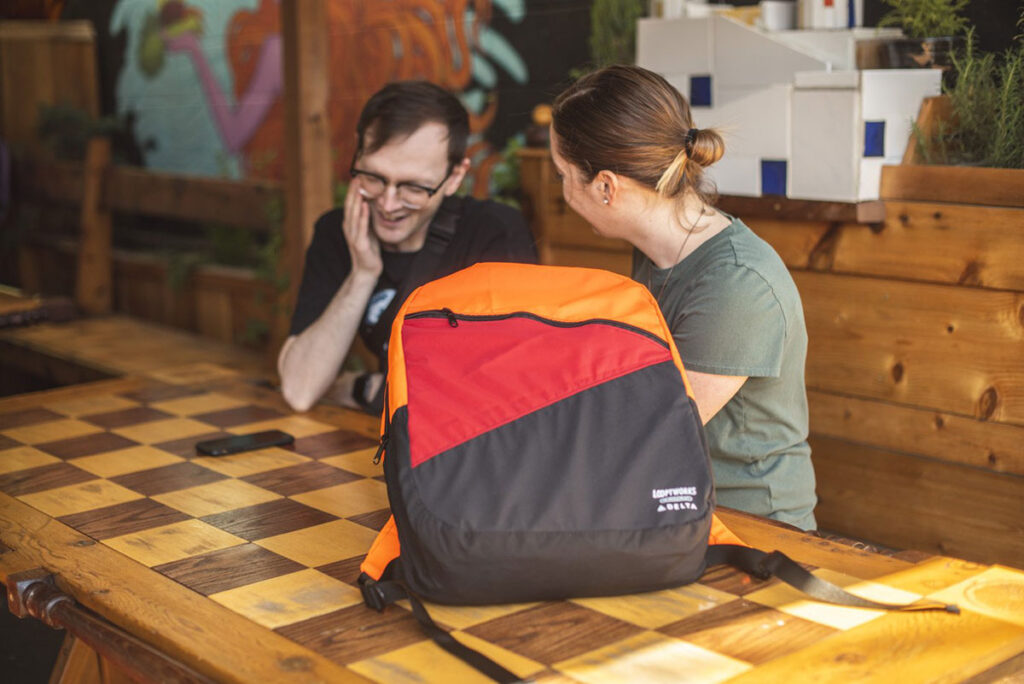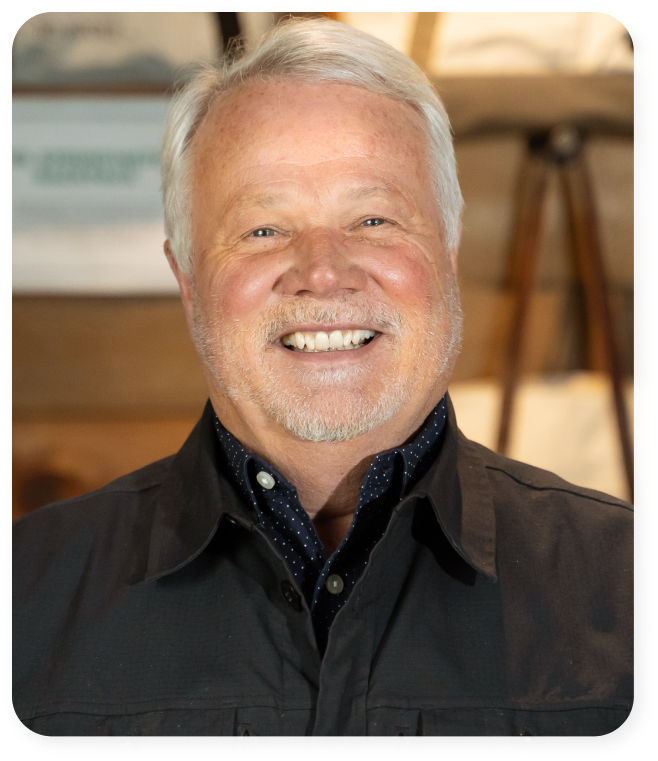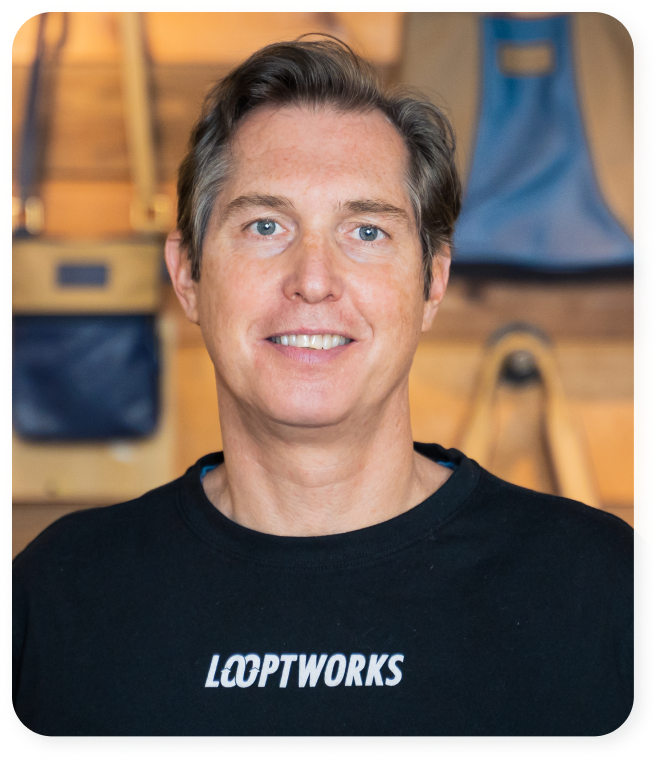

What is the difference between upcycling, downcycling and recycling? There are clear distinctions between the various ways we can reuse waste and other discarded materials. While upcycling and downcycling are both examples of recycling, not all recycling is considered equal.
When we convert discarded materials into something of equal or greater value, it is “Upcycled”. When a material or product is “Downcycled”, it is transformed into something of lesser value.
Let’s look at an example. Here are some textile scraps. On the left, black polyester scraps from the end of a bolt of cloth. On the right, brown scrap leather cut from the edge of a hide.

The original material was used to make bags and luggage. These leftover scraps — called excess — are now destined to be landfilled or incinerated. Instead, what if the materials are rescued and turned into a backpack?

Much better. The excess is upcycled into a backpack that has more value than the original materials. Aluminum and glass are also good candidates for upcycling. That’s because you can recycle these materials and end up with a raw material of equal quality.
By contrast, downcycling occurs when waste material is converted into something of lesser value. Instead of upcycling the polyester excess into a backpack, let’s melt it and downcycle it into yarn.

This is considered downcycling because the yarn is of lesser value than the piece of cloth it came from. Recycling plastics is often downcycling because the end product is a lesser-quality plastic.
All else equal, upcycling is better than downcycling because upcycling prolongs the useful life of materials. Once the backpack wears out, it can be torn up and used it to stuff a dog bed. After the dog bed wears out, the stuffing can be downcycled again into polyester yarn.

Making new materials requires significant resources, including water and energy. By prolonging the life of existing materials, the need to create new materials is delayed or forgone. Thus, resources are conserved.
Both upcycling and downcycling are important components of a “closed-loop” manufacturing system. That’s where the fun starts! In a true closed-loop scenario, a company owns the materials it creates forever. Any material created is collected and recycled to make the next run of products. Imagine a world where bottled-water companies owned the bottles they made forever! For starters, there’d be less plastic in the ocean, for another, some of them would probably get out of the business entirely or reimagine the model. Here’s another example from our backpack illustration:

As of this writing, there are no true closed-loop manufacturing systems, by which I mean there’s no company I’ve been able to find that collects and recycles 100% of the material it produces. But growing environmental, social and economic pressures are driving the need for low-impact products. Instances of upcycling and downcyclying will increase, moving us closer and closer toward that closed loop future. Our built world will increasingly mimic the natural world. Just like nothing is created or destroyed in an ecosystem, nothing will be created or destroyed in the process of making the products we need. How neat is that?
Did you like our bag example? As it turns out, we made some. In fact, everything we produce is upcycled. In this case, they’re upcycled from pre-consumer excess materials rescued from the outdoor gear and bag industry. To be clear, we do not downcycle them into dog beds or yarn… yet.

Reach out to us today!


Denine has over 20 years of experience driving new business opportunities for leading companies, including E.I. DuPont de Nemours & Company, Inc., The Dow Chemical Company, Outlast Technologies, and DST Systems. She holds a BS from the University of Pittsburgh and a Certification in Executive Management from the Kenan-Flagler School of Business at the University of North Carolina at Chapel Hill.

Tami is a senior accounting leader with over 16 years of experience in the manufacturing and textile industry. Her specialties include process development and implementation, mergers and acquisitions, job and project costing and analysis, and managing complex teams and technical projects. Tami has served as Chief Financial Officer and Controller for a variety of innovative companies, where her analytical skills and strategic mindset helped organizations create efficiencies in their financial systems.

Kelley is a passionate and strategically minded business development leader with more than two decades of experience in the sporting goods apparel industry. He has experience in product construction, league partnerships, retail relationships, supply chain management, sustainability, circularity, and carbon footprint management. Kelley builds successful partnerships by putting the customer first while simultaneously advancing his organization’s business objectives.

Suzy is a product leader and operations expert with more than 25 years of experience in the textile industry. She is passionate about finding creative solutions to complex problems and motivating people to action through vision, strategy, collaboration, and communication. Suzy has proven expertise in product development, sustainability, marketing, supply chains, and innovating processes and best practices to drive results.

Scott is a visionary leader with more than 32 years of experience in strategic branding, innovative product creation, supply chain sustainability, and sales and marketing for global organizations. He founded Looptworks in 2009 as an industry solution for turning excess materials into upcycled consumer products. In 2022, Scott transitioned the company to a B2B business model focused on eliminating global textile waste through closed-loop solutions.

Scott is a visionary leader with more than 32 years of experience in strategic branding, innovative product creation, supply chain sustainability, and sales and marketing for global organizations. He founded Looptworks in 2009 as an industry solution for turning excess materials into upcycled consumer products. In 2022, Scott transitioned the company to a B2B business model focused on eliminating global textile waste through closed-loop solutions.